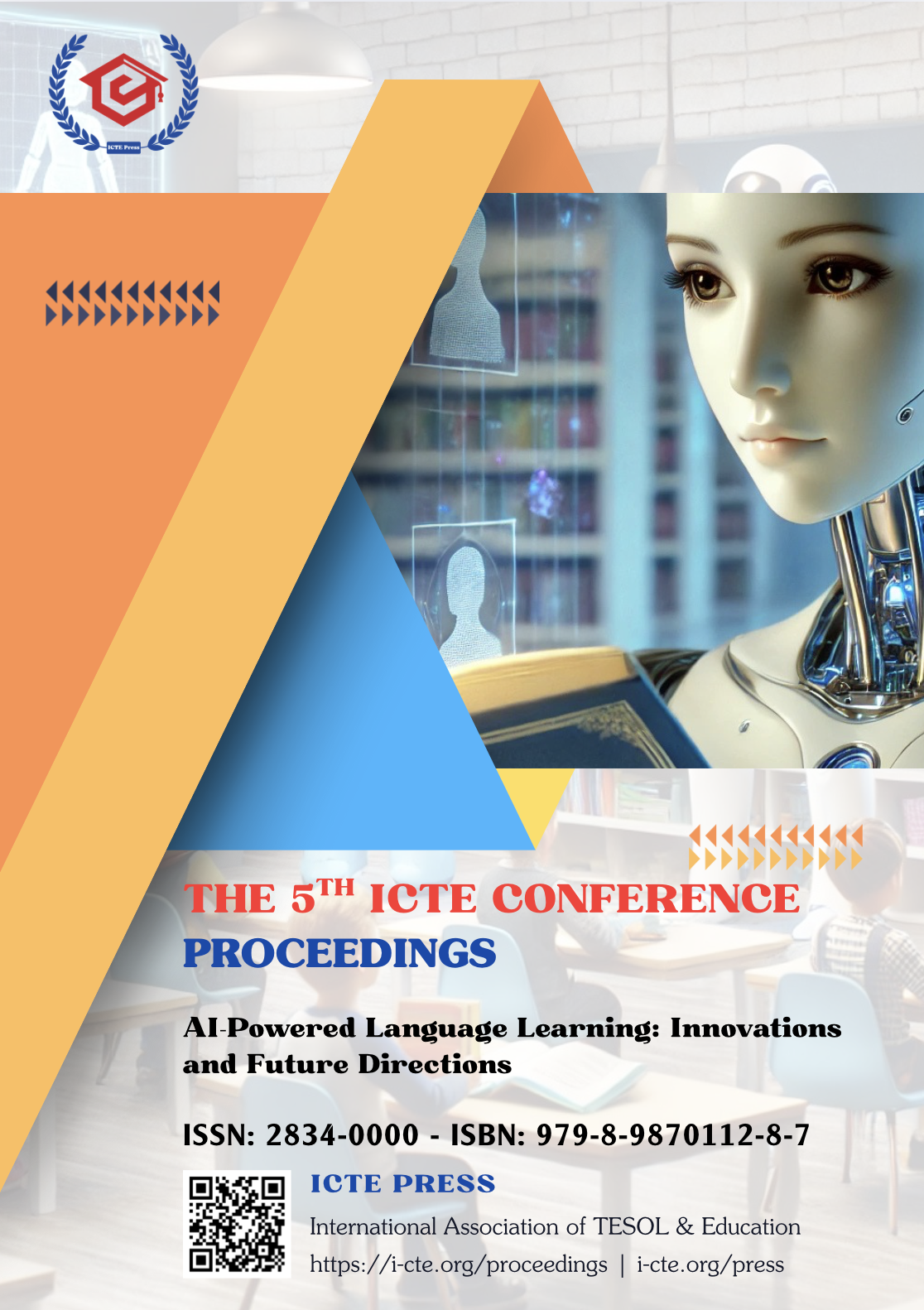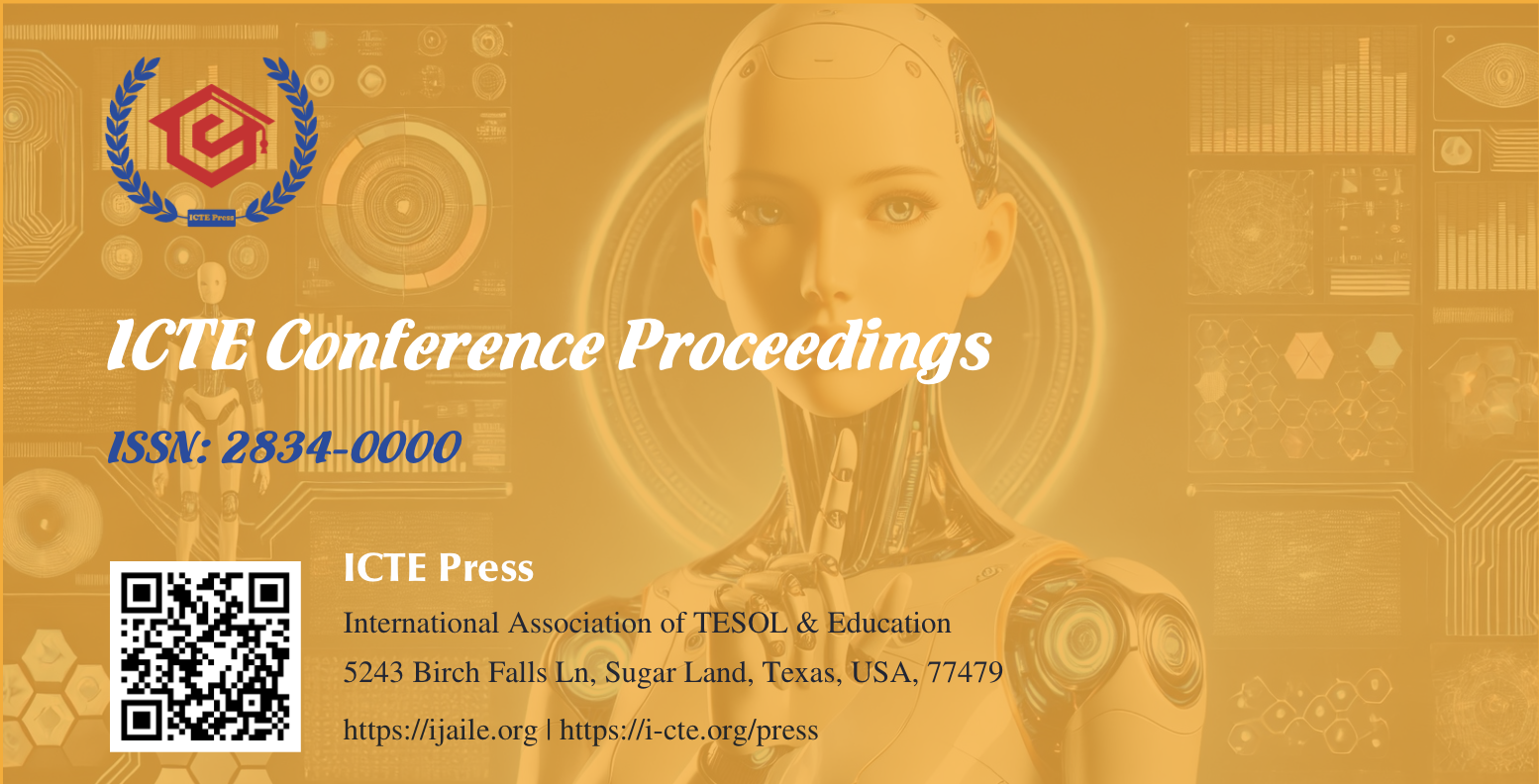Exploring Self-Learning of Nursing Students at VNUHCM through Camera-Integrated Translation Technology: Perceptions and Insights
DOI:
https://doi.org/10.54855/979-8-9870112-8-7_3Keywords:
integrated camera, translation, nursing, ESPAbstract
This study examined the relationship between camera-integrated translation technology and self-directed learning, and explored differences in perceptions across gender groups. A survey with 66 participants and 18 questions provided data for analysis using ANOVA and multiple linear regression analyzes. The results showed a strong connection between translation technology and self-directed learning, which means the integrated camera translation application has a positive impact on autonomy. Moreover, as expected, there are no differences in perception between genders regarding function, which is in line with previous studies. Last but not least, the research highlights the most affecting factor, which underscores the importance of focus and contextual relevance in improving translation-assisted learning. This study offers a valuable in-depth analysis of the perceptions and attitudes of both learners and instructors. Based on the mentioned perception, the writer offers implications for a pedagogical approach, including suitable classroom activities and the enhancement of supportive tools. Other suggestions, due to limitations including scale, plot survey, and descriptive data, are also mentioned for further research.
References
Abu-Rabia, S. (2004). Teachers’ role, learners’ gender differences, and FL anxiety among seventh-grade students studying English as a FL. Educational Psychology, 24(5), 711–721. https://doi.org/10.1080/0144341042000263006
Akayoğlu, S. (2017). Perceptions of Pre-service English Teachers Towards Computer Assisted Language Learning Course. Elementary Education Online, 16(3), 1220–1234. https://doi.org/10.17051/ilkonline.2017.330252
Alkarkhi, A. F. M., & Alqaraghuli, W. A. A. (2020). Chapter 7 - Regression Analysis. Applied Statistics for Environmental Science with R, 113–132. https://www.sciencedirect.com/science/article/pii/B9780128186220000071
Alzubi, A. A. F., & Singh, M. K. M. (2017). The Use of Language Learning Strategies through Smartphones in Improving Learner Autonomy in EFL Reading among Undergraduates in Saudi Arabia. International Journal of English Linguistics, 7(6), 59. https://doi.org/10.5539/ijel.v7n6p59
Bahri, H. (2016). Google Translate as a Supplementary Tool for Learning Malay: A Case Study at Universiti Sains Malaysia. Advances in Language and Literary Studies, 7(3). https://doi.org/10.7575/aiac.alls.v.7n.3p.161
Bandura, A. (1982). Self-efficacy mechanism in human agency. American Psychologist, 37(2), 122–147. https://doi.org/10.1037/0003-066X.37.2.122
Bin Dahmash, N. (2020). I Can’t Live Without Google Translate: A Close Look at the Use of Google Translate App by Second Language Learners in Saudi Arabia. Arab World English Journal, 11(3), 226–240. https://doi.org/10.24093/awej/vol11no3.14
Boyer, S. L., Edmondson, D. R., Artis, A. B., & Fleming, D. (2014). Self-Directed Learning: A Tool for Lifelong Learning. Journal of Marketing Education, 36(1), 20–32. https://doi.org/10.1177/0273475313494010
Brosius, F., & Brosius, G. (1989). SPSS-Programmierung Effizientes Datenmanagement und Automatisierung mit SPSS-Syntax Felix Brosius. In SPSS (pp. 1–23). McGraw-Hill.
Bui, T. T. T., & Le, M. T. (2023). Sociolinguistic Aspects on Contemporary English Language Teaching and Learning at Tertiary Levels in Vietnam. International Journal of Social Science And Human Research, 06(11), 6939–6945. https://doi.org/10.47191/ijsshr/v6-i11-49
Chen, N., & Hsieh, S. (2008). Effects of Short-Term Memory and Content. Language Learning & Technology, 12(3), 93–113.
Cronbach, L. J. (1951). Coefficient alpha and the internal structure of tests. Psychometrika, 16(3), 297–334. https://doi.org/10.1007/BF02310555
Duong, T. T. U., & Nguyen, M. H. (2024). Students’ Perspective on Applying AI in English Learning and Teaching – A Study at UEH. ICTE Conference Proceedings, 5(March), 91–102. https://doi.org/10.54855/ictep.2458
Elmayantie, C. (2015). The Use of Grammar Translation Method in Teaching English. Journal on English as a Foreign Language, 5(2), 125. https://doi.org/10.23971/jefl.v5i2.372
Fang, R. J., Tsai, H. L., Lee, C. J., Chang, Y. H., & Tsai, T. S. (2010). A study of theoretical framework on the perception of web-based self-directed learning environment. Proceedings of the 10th WSEAS International Conference on Multimedia Systems and Signal Processing, MUSP ’10, March 2012, 187–192.
Gerald, B. (2018). A Brief Review of Independent, Dependent and One Sample t-test. International Journal of Applied Mathematics and Theoretical Physics, 4(2), 50. https://doi.org/10.11648/j.ijamtp.20180402.13
Hoang, Q. V. (2021). The Differences of Individual Learners in Second Language Acquisition. International Journal of TESOL & Education, 1(1), 38–46. https://i-jte.phamho.com/index.php/journal/article/view/6
Humpage, S. (2000). An introduction to regression analysis. Sensors (Peterborough, NH), 17(9), 68–74. https://doi.org/10.1002/9781118267912.ch6
Khamkhien, A. (2010). Factors Affecting Language Learning Strategy Reported Usage by Thai and Vietnamese EFL Learners. Electronic Journal of Foreign Language Teaching, 7(1), 66–85.
Khotimah, K., Wahyudin, W., & Rohbiah, T. S. (2021). Students’ perception of google translate in online English learning. Jelts, 4(2), 78–85. http://dx.doi.org/10.48181/jelts.v4i2.12016
Kirschner, P. A., Sweller, J., Kirschner, F., & Zambrano, J. R. (2018). From Cognitive Load Theory to Collaborative Cognitive Load Theory. International Journal of Computer-Supported Collaborative Learning, 13(2), 213–233. https://doi.org/10.1007/s11412-018-9277-y
Kol, S., Schcolnik, M., & Spector-Cohen, E. (2018). Google Translate in Academic Writing Courses? The EuroCALL Review, 26(2), 50. https://doi.org/10.4995/eurocall.2018.10140
Lai, V. Du, Do, T. N. M., & Le, M. T. (2022). A Review of the Computer-Assisted Language Learning (CALL) on Teaching and Learning Writing. ICTE Conference Proceedings, 1(September), 11–28. https://doi.org/10.54855/ictep.12
Le, M. T. (2021). Students’ Attitude Towards Using Smartphones and Portable Devices for Studying Writing. International Journal of TESOL & Education, 1(3), 54–64. http://eoi.citefactor.org/10.11250/ijte.01.03.004
Le, M. T. (2025). Exploring User Perceptions of the Smartphone Camera Integrated Translation Function for Supporting English Language Learning Among Nursing Students. In K. D. Sin & T. N. A. Nguyen (Eds.), National Scientific Conference 2025 Emerging Trends In Teaching And Learning Foreign Languages (pp. 439–456). National University Ho Chi Minh City Publishing House.
Little, T. D. (2013). The Oxford Handbook of Quantitative Methods: Volume 1: Foundations. In The Oxford Handbook of Quantitative Methods: Volume 1: Foundations (Vol. 1). https://doi.org/10.1093/oxfordhb/9780199934874.001.0001
Ly, T. H. (2015). Confucian Influences on Vietnamese Culture. Vietnam Social Sciences, 5 (169), 71–81.
Mahmud, M., & Nur, S. (2018). Exploring students’ learning strategies and gender differences in english language teaching. International Journal of Language Education, 2(1), 51–64. https://doi.org/10.26858/ijole.v2i1.4346
Nguyen, M. T., & Le, M. T. (2024). Teachers And Students’ Self-Autonomy Perception in Utilizing Computer Assisted Language Learning (Call). International Journal of Religion, 5(10), 5407–5418. https://doi.org/10.61707/hwx0mj64
Nguyen, N. H. V., & Pham, V. P. H. (2024). AI Chatbots for Language Practices. International Journal of AI in Language Education, 1(1), 56-67. https://doi.org/10.54855/ijaile.24115
Paas, F., van Gog, T., & Sweller, J. (2010). Cognitive Load Theory: Advances in Research on Worked Examples, Animations, and Cognitive Load Measurement. Educational Psychology Review, 22(4), 375–378. https://doi.org/10.1007/s10648-010-9145-4
Park, H. J., Lee, Y., & Ko, J. G. (2021). Enabling Real-time Sign Language Translation on Mobile Platforms with On-board Depth Cameras. Proceedings of the ACM on Interactive, Mobile, Wearable and Ubiquitous Technologies, 5(2). https://doi.org/10.1145/3463498
Sagita, M., & Balqis, N. (2021). Students’ perception about google translation tool in learning English (A Descriptive Study at Jabal Ghafur University). Getsempena English Education Journal (GEEJ, 8(1), 26. https://doi.org/https://doi.org/10.46244/geej.v8i1.1209
Sato, T., Murase, F., & Burden, T. (2015). Is mobile-assisted language learning really useful? An examination of recall automatization and learner autonomy. 2015, 495–501. https://doi.org/10.14705/rpnet.2015.000382
Senior, J. (2019). Mobile Translation Apps. and Second Language Teaching; What do Student’s think? Proceeding of 2019 International Conference on Digitization: Landscaping Artificial Intelligence, ICD 2019, 135–141. https://doi.org/10.1109/ICD47981.2019.9105728
Shapovalov, Y. B., Bilyk, Z. I., Atamas, A. I., Shapovalov, V. B., & Uchitel, A. D. (2018). The potential of using google expeditions and google lens tools under STEM-education in Ukraine. CEUR Workshop Proceedings, 2257, 66–74. https://doi.org/10.31812/pedag.v51i0.3659
Sujarwo, S. (2020). Students’ Perceptions of Using Machine Translation Tools In the EFL Classroom. Al-Lisan, 6(2), 230–241. https://doi.org/10.30603/al.v6i2.1333
Sweller, J. (2011). Cognitive Load Theory. In Psychology of Learning and Motivation - Advances in Research and Theory (Vol. 55). Elsevier Inc. https://doi.org/10.1016/B978-0-12-387691-1.00002-8
Sweller, J. (2023). The Development of Cognitive Load Theory: Replication Crises and Incorporation of Other Theories Can Lead to Theory Expansion. Educational Psychology Review, 35(4), 1–20. https://doi.org/10.1007/s10648-023-09817-2
Tumbal, S., Liando, N. V. F., & Olii, S. T. (2022). Students’ Perceptions Toward the Use of Google Translate in Translating. Kompetensi, 1(02), 313–320. https://doi.org/10.53682/kompetensi.v1i02.1853
Wahyudin, A. Y., Pustika, R., & Simamora, M. W. (2021). Vocabulary Learning Strategies of Efl Students At Tertiary Level. The Journal of English Literacy Education: The Teaching and Learning of English as a Foreign Language, 8(2), 101–112. https://doi.org/10.36706/jele.v8i2.15647
Yeung, A. S., Lau, S., & Nie, Y. (2011). Primary and secondary students’ motivation in learning English: Grade and gender differences. Contemporary Educational Psychology, 36(3), 246–256. https://doi.org/10.1016/j.cedpsych.2011.03.001
Downloads
Published
How to Cite
Issue
Section
License
Copyright (c) 2025 Le Minh Trung

This work is licensed under a Creative Commons Attribution 4.0 International License.
Authors retain copyright and grant the picte the right of first publication with the work simultaneously licensed under a Creative Commons Attribution 4.0 International License that allows others to share the work with an acknowledgment of the work's authorship and initial publication in this journal.
Authors are able to enter into separate, additional contractual arrangements for the non-exclusive distribution of the proceedings' published version of the work (e.g., post it to an institutional repository, in a journal, or publish it in a book), with an acknowledgment of its initial publication in this proceedings.
Authors are permitted and encouraged to post their work online (e.g., in institutional repositories or on their website) prior to and during the submission process.










